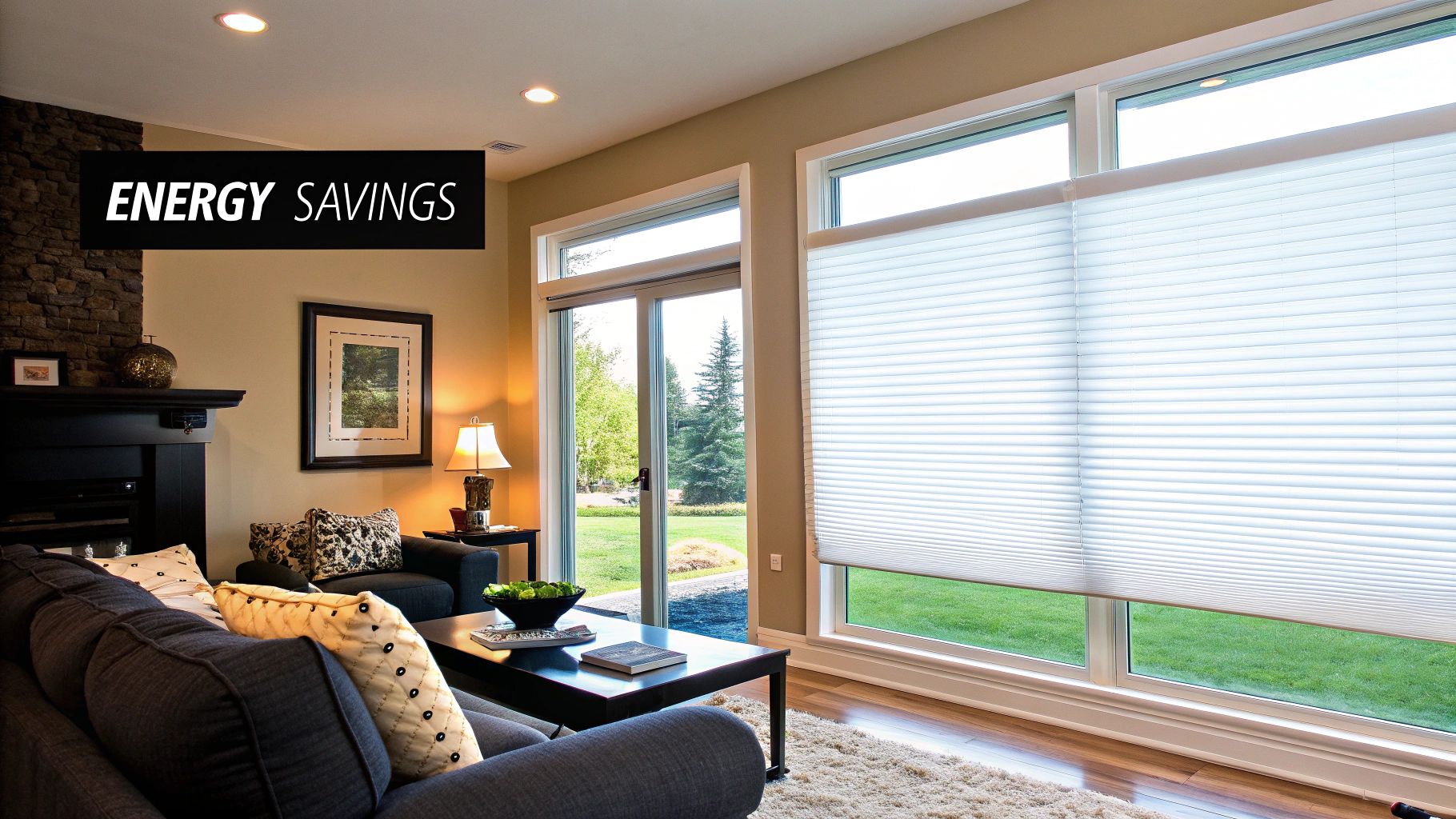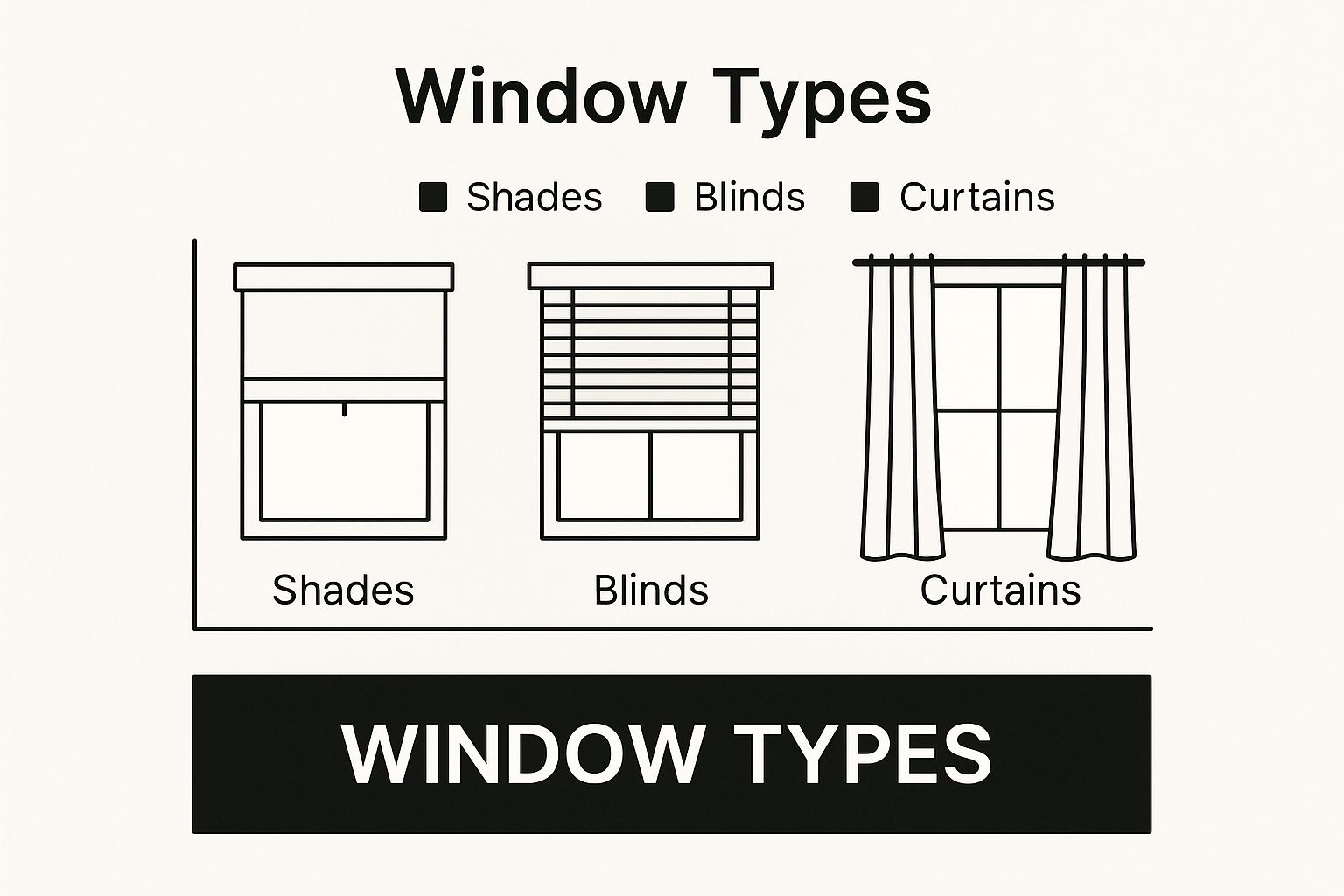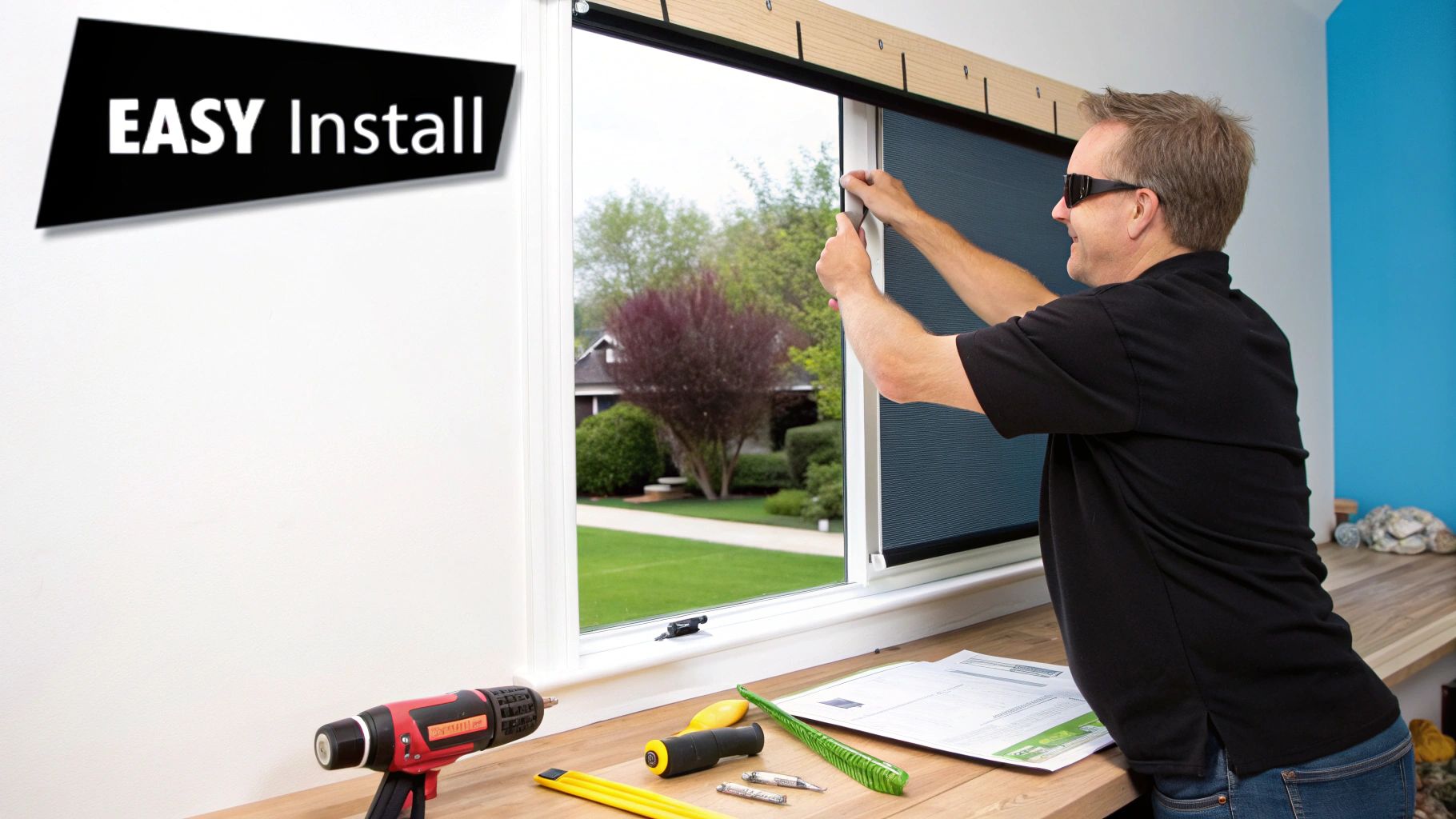Energy Efficient Window Coverings: Your Smart Home Guide
- Johann Reardon

- Jul 18
- 14 min read
Why Your Windows Are Energy Vampires (And How To Stop Them)

Think of your home as a carefully constructed, insulated fortress protecting you from the outside world. Your walls are thick and strong, keeping the elements at bay. But your windows? They're often the weak link, letting precious heated or cooled air escape like tiny, invisible thieves. This makes your HVAC system work harder, costing you more money. That's where energy-efficient window coverings come into play. They add a much-needed layer of insulation, trapping air and reducing energy transfer.
Imagine wearing a heavy winter coat, but with sleeves made of fishnet. You'd be freezing! Your windows are similar. Even double-paned windows have significantly lower R-values (think of this as a measure of how well a material resists heat flow) than your walls. Your walls might have an R-value of 13, while your windows could be as low as R-1 to R-3. Energy-efficient window coverings help bridge that insulation gap.
Picture a drafty old house on a blustery winter day. The heating system struggles to keep up, and the homeowner is bundled in layers. By installing cellular shades, they create an insulating barrier against the cold, potentially reducing heat loss by up to 40%. That's a real difference you can feel in your wallet!
But it’s not just about the material. Proper installation is key. A small gap around a poorly fitted shade can completely negate its insulating benefits, like leaving a window cracked open. This is why accurate measurements and professional installation are so important. Home Blinds & Floors offers free in-home consultations to ensure a perfect fit and maximum energy savings.
This increased focus on energy efficiency isn’t just a passing trend. The market for energy-efficient windows is booming. In 2024, the market was valued at $12.53 billion, and projections show it reaching $16.33 billion by 2029. This growth is fueled by consumers looking for sustainable solutions. Learn more about the growing market for energy-efficient windows. This highlights the growing awareness of energy conservation. Choosing window coverings isn't just about looks anymore; it's about creating a more comfortable and sustainable home. Home Blinds & Floors, a family-owned and locally operated business, understands this. They offer a wide selection of energy-efficient choices, from custom blinds and shades to plantation shutters, helping you find the perfect options for your style and energy needs.
Cellular Shades: The Honeycomb Heroes Of Energy Savings

The infographic above gives you a quick overview of different window coverings. Notice how cellular shades have a distinct honeycomb structure? That's the secret behind their energy-saving superpower.
Think of them like a cozy winter coat for your windows. These cellular shades, with their honeycomb design, are top-tier when it comes to energy efficiency. Those little pockets of air trapped within the cells act like individual insulators, preventing heat from escaping. Home Blinds & Floors offers a wide array of custom window coverings, including cellular shades, perfectly fitted to your windows. The result? Real savings on your energy bills—some homeowners report saving over $200 per window each year.
Single, Double, or Triple-Cell: Choosing the Right Level of Insulation
When it comes to cellular shades, more cells often mean more energy savings. Single-cell shades offer decent insulation, but double-cell and triple-cell shades significantly boost performance. Each additional layer of cells adds another pocket of air, further reducing heat transfer. It’s similar to adding more insulation to your attic—more layers mean better protection against the elements.
If you live in a mild climate, single-cell shades might do the trick. But for those in areas with extreme temperatures, double or triple-cell shades are the way to go for maximum protection and energy savings. Companies like Namaste Solar are great examples of organizations embracing sustainable energy practices.
Beyond the Cells: Fabric and Features That Boost Efficiency
The effectiveness of cellular shades goes beyond their unique cell structure. The fabric itself plays a crucial role. Reflective backings, for instance, can bounce sunlight away from your windows, preventing heat from entering your home during the summer months. This helps lighten the load on your air conditioner.
There are also innovative smart fabrics making their way onto the market. These fabrics adapt to temperature changes, increasing insulation when it's cold and becoming more breathable when it's warm. It’s like having window coverings that automatically adjust to the seasons.
Let’s take a closer look at how these different cell configurations perform:
Shade Type | R-Value Range | Energy Savings Potential | Best Climate Use |
|---|---|---|---|
Single-Cell | 2.0 - 4.0 | Moderate | Mild Climates |
Double-Cell | 3.0 - 5.0 | High | Moderate Climates |
Triple-Cell | 4.0 - 7.0 | Highest | Extreme Climates |
The table above illustrates the relationship between cell structure, R-value (a measure of insulation), and energy savings. As you can see, triple-cell shades offer the highest R-value and therefore the greatest energy savings. Choosing the right shade type depends on your climate and budget.
Professional Measurement: Why It Matters
Even the most advanced cellular shades won’t perform optimally if they don't fit properly. Even a small gap around the edges can let precious heated or cooled air escape, reducing their effectiveness—it’s like leaving a window cracked open. How to Choose Window Treatments provides further insights into selection and installation. This is why professional measurement and installation are so important. Experts, like those at Home Blinds & Floors, ensure your cellular shades fit perfectly, maximizing their energy-saving potential. This precise approach is key to their commitment to customer satisfaction.
Smart Motorized Treatments: Your Home's Energy Assistant
Imagine your window coverings adjusting themselves throughout the day, keeping your home cool in the summer and warm in the winter, all without lifting a finger. That's the power of smart motorized window treatments. These aren't just fancy gadgets; they're practical tools for managing your home's energy consumption.
Automation: Beyond Convenience, Real Savings
Think about a typical summer afternoon. The sun beats down, and if you forget to close your blinds, your house turns into an oven. Then, in the winter, leaving blinds open at night lets valuable heat escape. Smart motorized treatments solve these problems automatically.
These systems use sensors and programming to respond to changing conditions. Picture your shades lowering as the sun intensifies, preventing that unwanted solar heat gain. Later, as the sun sets, they rise, allowing in natural light and even a bit of passive solar heating. Some advanced systems even track the sun's path, making adjustments throughout the day that you simply couldn't manage manually.
And the results? Tech-savvy homeowners using these systems are seeing significant reductions in their energy bills, sometimes by as much as 25%. Want to delve deeper into the technology behind these systems? Check out our guide on trends in motorization.
Integration and Control: Seamless Energy Management
Smart motorized treatments integrate smoothly with popular smart home platforms like Nest and Alexa. This means you can control your window coverings from your phone, tablet, or even with voice commands. You can also set schedules to automate adjustments based on the time of day, weather, or your own preferences.
For example, you might program your shades to lower during peak energy hours when electricity rates are highest, saving you money. Or, create a "good morning" scene that gradually raises your bedroom shades as you wake up. It's all about customizing your system to fit your lifestyle.
The demand for energy-efficient solutions is driving huge growth in the window coverings market. By 2035, this market is expected to be worth a staggering USD 43.8 billion, boosted by the increasing popularity of smart home technology and motorized window coverings. Learn more about this growing market from Future Market Insights.
Cost vs. Benefit: When Does Smart Pay Off?
Smart motorized treatments do have a higher initial cost compared to traditional manual options. However, the long-term energy savings they offer can more than make up for that initial investment. At Home Blinds & Floors, we help our customers navigate this cost-benefit analysis.
The payback period – the time it takes for the energy savings to equal the initial cost – depends on factors like your local climate, the size of your home, and your typical energy usage. If you live in an area with extreme temperatures or high energy costs, you'll likely see a faster return on your investment. Don't forget about the added benefits like increased home value and reduced wear and tear on your heating and cooling systems.
Working with a trusted provider like Home Blinds & Floors ensures you select a system tailored to your specific needs and budget. Our expert installation teams guarantee optimal performance and system longevity, maximizing your comfort and long-term savings. We’re here to help you make the right choices for your home.
Plantation Shutters and Custom Blinds: Timeless Efficiency
Sometimes, the best solutions are tried and true. Plantation shutters and custom blinds, with their enduring appeal, are surprisingly effective at saving energy. They offer a compelling blend of style, durability, and control over light and heat. Home Blinds & Floors provides expert installation of custom plantation shutters, ensuring a perfect fit and maximizing energy efficiency.
Adjustable Louvers: Your Personalized Climate Control
Think of the adjustable louvers on shutters and blinds like a dimmer switch for your windows. Fully open, they welcome in light and warmth. Partially closed, they soften the sunlight, offer privacy, and still allow some natural light to filter through. Fully closed, they act like a solid barrier against light and heat transfer, almost like adding an extra layer of insulation to your windows. This level of control empowers you to fine-tune your home's temperature and light throughout the day, optimizing both comfort and energy savings.
Material Matters: Choosing the Right Balance
The material you select for your shutters or blinds affects both energy performance and how long they last. Composite materials provide durability and affordability. Real wood, on the other hand, offers superior insulation and a classic aesthetic. Home Blinds & Floors offers a wide array of both composite and wood options, helping you select the best material for your needs and budget. For example, wood shutters, with their natural insulating properties, can significantly reduce heat transfer. Composite shutters, though slightly less insulating, offer excellent resistance to moisture and warping, making them perfect for humid environments.
To help you compare options, take a look at the table below:
Energy Performance Showdown: Shutters vs Blinds vs Shades
Head-to-head comparison of energy efficiency, cost, and durability across major window covering categories
Treatment Type | Average R-Value | Initial Cost Range | Lifespan | Maintenance Level |
|---|---|---|---|---|
Plantation Shutters (Wood) | 3.17 - 5.33 | $25 - $50 per sq ft | 25+ Years | Low |
Plantation Shutters (Composite/PVC) | 2.75-4.0 | $15- $35 per sq ft | 15+ Years | Low |
Cellular Shades | 2.0-5.0 | $20-$60 per sq ft | 10-15 Years | Low |
Wood Blinds | 1.0-2.5 | $15- $30 per sq ft | 10-15 Years | Moderate |
Vinyl/Aluminum Blinds | 0.5-1.5 | $10 - $25 per sq ft | 5-10 Years | Low |
As you can see, shutters generally offer the highest R-values and longest lifespan, while blinds tend to be more budget-friendly. Shades fall somewhere in between, offering good energy efficiency and a variety of styles. Ultimately, the best choice depends on your specific priorities and budget.
For broader context on integrating technology into your home, you might find this interesting: AI in Customer Support. You can also see shutters and motorized solar shades in action here: discovering the benefits of shutters and motorized solar shades in our showcase home video.
Professional Installation: Maximizing Performance and Longevity
Just like a well-tailored suit, plantation shutters and custom blinds need to fit perfectly to look and function at their best. Even a small gap between the window frame and the covering can compromise their insulation value. Professional installation from a company like Home Blinds & Floors ensures accurate measurements, a snug fit, and maximum energy efficiency. Their experienced installers are knowledgeable about various window types and can guarantee optimal performance, no matter your home's architectural quirks.
Home Blinds & Floors, a family-owned and locally operated business, offers a convenient one-stop shop for both flooring and window treatments. This personalized service exemplifies their commitment to customer satisfaction and reflects decades of industry experience. By opting for professional installation from a trusted company like Home Blinds & Floors, you’re not just purchasing window coverings; you’re investing in long-term energy savings, increased home value, and enduring beauty. They offer custom blinds and shades in a variety of materials and styles to complement any décor.
Decoding Energy Performance: What The Numbers Really Mean

You often hear about R-values when talking about energy-efficient window coverings. Think of the R-value as a measure of how well a material resists heat flow – like a score on an insulation test. A higher R-value generally means better insulation.
But it's not the entire picture. It's like judging a meal solely on its aroma – enticing, but you need a taste to know the real story. There's more to energy efficiency than just this one number.
Beyond R-Values: The Real Factors Affecting Energy Efficiency
R-values provide a good starting point, but other elements often have a bigger impact on your actual energy savings. Air leakage, for instance, can make a huge difference. You could have coverings with a fantastic R-value, but gaps around the edges will let all that precious heated or cooled air escape. Imagine a thick winter coat with holes – it wouldn't keep you very warm! This is where professional installation, like the kind offered by Home Blinds & Floors, becomes essential. They’ll measure precisely to ensure a snug fit, minimizing air leaks and maximizing your energy savings. For a deeper dive, check out their guide: The Comprehensive Guide to Energy-Efficient Window Treatments Across All Seasons.
Then there's the solar heat gain coefficient (SHGC), which tells you how much solar heat passes through the covering. A lower SHGC means less heat enters your home. In sunny locations, a low SHGC can be even more important than a high R-value, especially in the summer. This is where solutions like solar shades, also available through Home Blinds & Floors, can be incredibly effective. They block a significant amount of solar heat while still allowing natural light in.
Thermal bridging is another key factor. This happens when heat transfers through a more conductive material, like the frame of the window covering. Think of a metal spoon in a hot cup of coffee – the spoon heats up and transfers that heat to your hand. Home Blinds & Floors addresses this with careful material choices and specific installation techniques to minimize thermal bridging and boost the effectiveness of your window coverings.
The increasing popularity of energy-efficient window coverings isn't just about saving money. It's also tied to broader architectural trends favoring natural light and open spaces. As our world becomes more urban, particularly in growing economies, the need for window coverings that balance light, privacy, and modern design becomes even more important. You can explore this evolving market further here.
From Numbers to Dollars: Calculating Your Savings
Turning R-values and SHGCs into actual dollar savings means considering your home's unique features and your local climate. While energy auditors use complex software to model energy flow and estimate potential savings, simpler online calculators can also give you a helpful starting point.
Home Blinds & Floors assists customers with these calculations during free in-home consultations. They factor in your home’s location, window dimensions, and typical energy usage to estimate potential savings with various energy-efficient window coverings. This personalized approach helps you make informed choices that fit both your budget and your energy goals.
The Real Math: Investment Payback and Long-Term Savings
Let's talk dollars and sense. How much do energy-efficient window coverings actually cost, and what kind of savings can you expect down the road? We'll explore the payback period – the time it takes for your energy savings to equal your initial investment – for various types of window coverings. We'll even look at real-world utility bill comparisons from homeowners in different climates. Interested in budgeting for window coverings? Check out our guide.
Unveiling the Return on Investment: Real-World Examples
Some energy-efficient window coverings offer a quick return, like a fast-growing stock. Others, like a reliable bond, take a bit longer to mature. For instance, some homeowners discover that cellular shades, with their excellent insulation, pay for themselves in energy savings within a few years. Other options, like plantation shutters, while offering great energy efficiency and boosting home value, might have a slightly longer payback period. We'll examine real before-and-after energy usage data from families who diligently tracked their costs. This will help you understand which treatments offer the quickest wins and which are more of a long-term investment.
Hidden Savings: Rebates and Incentives
Think of rebates and tax incentives as surprise coupons for your window coverings. Many homeowners miss out on these opportunities to significantly reduce their upfront costs. These can include federal tax credits for energy-saving upgrades and utility company programs that reward you for making your home more efficient. Home Blinds & Floors can help you navigate these programs and squeeze out every last penny of savings.
Beyond Utility Bills: The Full Savings Picture
The benefits of energy-efficient window coverings go beyond just smaller utility bills. These treatments can actually increase your home’s value, making it a more attractive prospect for potential buyers. After all, who wouldn’t want a home that's both comfortable and energy-efficient?
They also reduce wear and tear on your HVAC system. By lessening the load on your heating and cooling, you'll extend its lifespan and avoid costly repairs. It's like giving your HVAC system a vacation, allowing it to run smoothly and last longer.
Finally, and perhaps most importantly, energy-efficient window coverings enhance your overall comfort. They create a more consistent indoor temperature, eliminating drafts and reducing temperature swings. This means a more comfortable and enjoyable living space.
Professional Installation: Maximizing Your Investment
Professional installation from experienced companies like Home Blinds & Floors is key to getting the most out of your energy-efficient window coverings. Their expert team ensures accurate measurements and a perfect fit, maximizing both your immediate comfort and your long-term savings. As a family-owned and locally operated business, Home Blinds & Floors offers a wide selection of custom window coverings, including custom blinds and shades. This means they have the perfect energy-efficient solutions tailored to your home's unique needs. Their expert installation ensures your chosen window coverings perform at their best, boosting your home’s overall energy efficiency. This commitment to quality and personalized service makes them an ideal partner for upgrading your window treatments and maximizing your return on investment.
Your Action Plan: From Decision To Installation Success
Ready to make your home a comfortable and energy-efficient sanctuary? Let's create a personalized plan for choosing and installing window coverings that truly make a difference. We’ll cover practical checklists, expert advice, and smart strategies to ensure your project is a success, from your initial evaluation to long-term care.
Assessing Your Needs and Prioritizing Upgrades
First, let's take a look at your existing windows. Do you feel drafts? Which rooms get too hot in the summer or too cold in the winter? This assessment helps you pinpoint where energy-efficient window coverings will be most effective. Focus on the rooms you use most, like living rooms and bedrooms. If budget is a factor, consider a phased approach. Start with the windows that cause the most trouble and gradually upgrade the rest. Home Blinds & Floors offers free in-home consultations, helping you create a prioritized plan that fits your budget and energy-saving goals.
Measuring for Success: Precision is Key
Accurate measurements are essential for optimal performance. Even coverings with high R-values can lose effectiveness if they don't fit properly, allowing air to leak around the edges. Think of it like wearing a warm coat but leaving it unzipped – you lose all that precious heat! Home Blinds & Floors provides professional measurement services to ensure a perfect fit for maximum energy savings. Their expertise takes the guesswork out of the process and ensures your window coverings work as designed.
Researching Installers and Comparing Quotes
Choosing the right installer is just as important as choosing the right window coverings. Look for experienced professionals with a strong track record, like the team at Home Blinds & Floors. When comparing quotes, don't just look at the price. Consider the installer's reputation, warranty, and what services are included. Be wary of unusually low bids, which could mean they’re cutting corners or using inferior materials. Ask about their installation process and how they handle unexpected issues. A reputable installer will be upfront and answer your questions thoroughly. Home Blinds & Floors offers competitive pricing and personalized service. As a family-owned and locally operated business, they value customer satisfaction and stand behind their work.
Staging Your Project for Budget Management
If you can't upgrade all your windows at once, a staged approach might be best. Begin with rooms that offer the most potential energy savings, such as those with large windows or south-facing exposures. As your budget allows, gradually upgrade the remaining windows. This phased approach allows you to save energy over time without breaking the bank.
Maintaining Your Investment: Long-Term Care and Troubleshooting
Once your energy-efficient window coverings are installed, proper maintenance keeps them working effectively. Regular cleaning, lubricating moving parts, and addressing any issues promptly will extend their lifespan and maximize their energy-saving potential. Home Blinds & Floors offers guidance on maintaining your specific type of window coverings, ensuring they perform at their best for years to come. They offer troubleshooting advice for common problems and resources for ongoing energy monitoring, letting you track your savings and catch any potential problems early on. With Home Blinds & Floors' support, you can enjoy the comfort and energy efficiency of your window coverings for years.
Ready to start saving energy and boosting your home's comfort? Schedule a free in-home consultation with Home Blinds & Floors today. Their experts will guide you in selecting the perfect energy-efficient window coverings and ensure a flawless installation. Visit Home Blinds & Floors to learn more and schedule your consultation.

.avif)
Comments